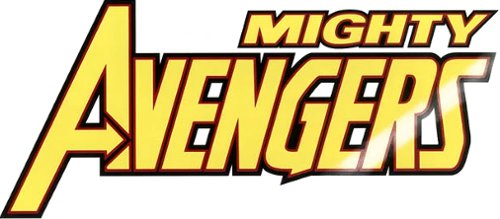Irredeemable Ant-Man – (2006-2007)
With the death of Scott Lang, the identity of Ant-Man was available and, this time, Marvel seemed to want to do something different. One of the most significant things was that this new Ant-Man was to get his own series. Throughout the forty-four years since an Ant-Man first appeared in comics, this would be the first series with Ant-Man in the name of the title.
The writer for this series was Robert Kirkman, who had already gained a name for himself. By 2006, he had been writing the critically acclaimed The Walking Dead at Image for three years and 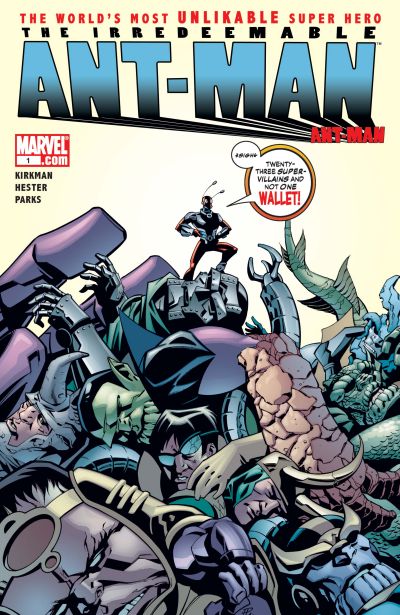 had started a super-hero series there called Invincible. He was also currently writing two titles at Marvel, Ultimate X-Men and a new Marvel Team-Up series (the third one of that name). It seems that Marvel offered an Ant-Man title to Kirkman and suggested that he use a resurrected Scott Lang, who had appeared as a zombie in Kirkman’s alternate universe series Marvel Zombies. Kirkman, however, pushed back and decided to create a new character who would not exactly be a “hero.” To the contrary, he would be a self-styled “dirtbag.”
had started a super-hero series there called Invincible. He was also currently writing two titles at Marvel, Ultimate X-Men and a new Marvel Team-Up series (the third one of that name). It seems that Marvel offered an Ant-Man title to Kirkman and suggested that he use a resurrected Scott Lang, who had appeared as a zombie in Kirkman’s alternate universe series Marvel Zombies. Kirkman, however, pushed back and decided to create a new character who would not exactly be a “hero.” To the contrary, he would be a self-styled “dirtbag.”
As with Scott Lang’s first appearance, the first issue of the series started in medias res in the “present,” with a new individual in an Ant-Man suit and then jumped back to six months earlier. For the first six issues, each issue told the story in these two time periods, with the flashbacks growing ever-closer to the present. In the past, the reader was introduced to Eric O’Grady, a low-level S.H.I.E.L.D. agent, serving on a S.H.I.E.L.D. helicarrier. Grounding it in recent continuity, Kirkman had the story begin during the events in the Wolverine (3rd series) story “Enemy of the State,” in which a brainwashed Wolverine downed a S.H.I.E.L.D. Helicarrier. Through a series of events, O’Grady came into possession of a prototype Ant-Man suit built by Hank Pym for the US military, to be used in missions of espionage.
For a few issues, O’Grady hid the fact that he had stolen the suit. However, faced with getting caught and arrested, O’Grady fled S.H.I.E.L.D. and went on the run. The second six issues of the 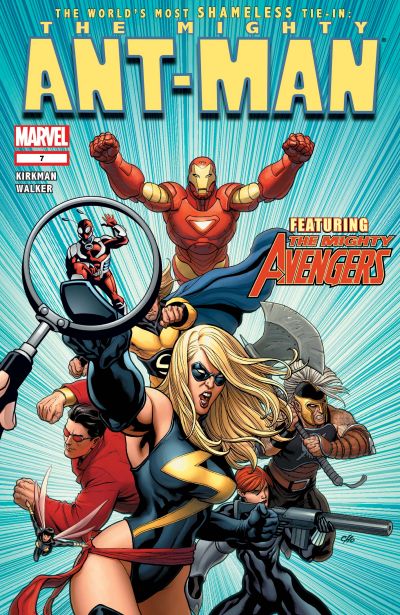 series followed O’Grady evading capture, utilizing his Ant-Man identity for personal gain and leering at women as they showered. Again, Kirkman grounded the series in recent continuity, having this new Ant-Man witness the ramifications of the aftermath of the Super-Hero Civil War regarding registration in general and the Initiative specifically. Also, and against his own instincts, Ant-Man played a very ancillary part in the World War Hulk crisis.
series followed O’Grady evading capture, utilizing his Ant-Man identity for personal gain and leering at women as they showered. Again, Kirkman grounded the series in recent continuity, having this new Ant-Man witness the ramifications of the aftermath of the Super-Hero Civil War regarding registration in general and the Initiative specifically. Also, and against his own instincts, Ant-Man played a very ancillary part in the World War Hulk crisis.
It was at this point that O’Grady was finally captured and arrested. However, when the agent tracking him had gone too far, an opening for O’Grady’s unparalleled ability to prevaricate allowed him to talk himself out of prison. Instead, O’Grady was returned to his old job and the Ant-Man suit was confiscated. Much to his surprise, however, when all of the other recruits failed to utilize the suit effectively, S.H.I.E.L.D. director Tony Stark offered it back to O’Grady, who accepted.
Unfortunately, while the series received critical acclaim for Kirkman’s writing and an original take on a well-known property, sales were not enough to save it from cancelation. The Irredeemable Ant-Man ended with #12.
| Writers | Artists |
|---|---|
|
|
Avengers: the Initiative – (2008-2009)
Although his series had been canceled, the new Ant-Man did not have long to wait in character limbo. Writer Dan Slott quickly snatched the incorrigible character and brought him to one of his 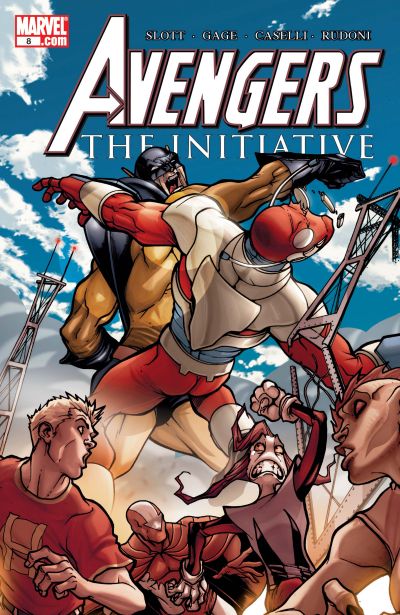 current ongoing titles – Avengers: the Initiative. Appearing in the new series with #8, Eric O’Grady was to become one of the newest recruits training at the Initiative’s boot camp, for later assignment in one of the teams comprising the Fifty States Initiative.
current ongoing titles – Avengers: the Initiative. Appearing in the new series with #8, Eric O’Grady was to become one of the newest recruits training at the Initiative’s boot camp, for later assignment in one of the teams comprising the Fifty States Initiative.
Ironically, one of the recruits-in-training was young Cassandra Lang, now the teenage hero known as Stature. As the book was very much an “ensemble” cast, O’Grady’s role at first was not large, but Slott made sure for Cassie to take a disliking to the new Ant-Man, who clearly did not honor the identity as her father did.
Stakes in the series rose with #14, which coincided with the Marvel’s Secret Invasion crossover event. When the invasion began, O’Grady’s powerful sense of self-preservation kicked in and he shrunk to ant-size to avoid being deployed to face the invaders. Little did he realize that his hiding would put him in the unique position to learn that Hank Pym himself was a Skrull, meaning that the Pym who had designed his new suit was an alien imposter. O’Grady did his best to avoid direct fighting during the rest of the crisis. Not only did his general cowardice go unnoticed, but O’Grady found himself promoted by Norman Osborn. Having managed to parlay his role in ending the Skrull crisis, Osborn was now in charge of H.A.M.M.E.R., the organization that was replacing S.H.I.E.L.D., and he wanted to assemble a new team of Thunderbolts comprised of morally questionable individuals. The Irredeemable Ant-Man fit the bill.
| Writers | Artists |
|---|---|
|
|
Thunderbolts (1st series) – (2009-2010)
The initial concept of the Thunderbolts at the beginning of 1997 was that of a group of super-villains disguising themselves as a new group of super-heroes in order to effect nefarious ends. The concept evolved soon thereafter with the group of former villains attempting to go the straight-and-narrow, becoming actual heroes in their own right. In this post-Secret Invasion status quo, Norman Osborn was America’s “top cop” and was attempting to use his new power to gain even more power. The comics that followed this personal crusade were stamped with the title “Dark Reign,” which served as more of a theme than an actual crossover.
One of the ways Norman sought to assemble power was to dispose of those in his way. This new group of Thunderbolts was to be Osborn’s personal hit squad. For O’Grady, this set what was (for him) a moral dilemma. While he was always one to take shortcuts and step over those in his way, he was never exactly a villain but more of a “cad” or a self-admitted “dirt bag.” Writer Andy Diggle would do his best to depict this fine line O’Grady was walking, as well as his renowned cowardice and lechery.
The events of the Siege crossover brought an end to Norman Osborn, the H.A.M.M.E.R. organization and the Thunderbolts team as well. In his mania, Osborn ordered the Thunderbolts (and all of H.A.M.M.E.R.) to attack Asgard, which was currently floating ten feet above a remote area of Oklahoma. The whole affair proved a debacle for Osborn, with the madness he had worked so hard to repress coming to the fore for all the world to see. By the end, Osborn was under arrest and the Thunderbolts were not so much disbanded as abandoned. For Eric O’Grady, it was the perfect opportunity to slip away unnoticed.
| Writers | Artists |
|---|---|
|
|
Secret Avengers (1st series) – (2010-2013)
Following the events of the Siege crossover, Marvel editorial revamped the tone of the entire Marvel Universe with a branding labeled “the Heroic Age.” Several titles, such as Avengers and 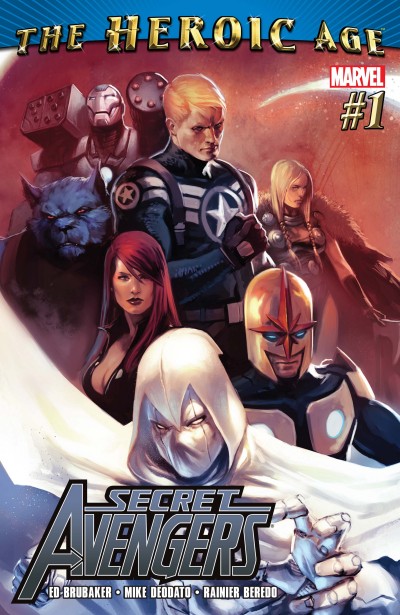 New Avengers, were relaunched with new #1s and a more positive outlook, in contrast the dark tone of the Dark Reign period. Nevertheless, writer Ed Brubaker helmed a new series which embraced the spirit of this new Heroic age, but was also grounded it in a noirish, spy theme. The result was the first Secret Avengers series. To date, there have been three series with such names, though the one beginning in 2010 was the first.
New Avengers, were relaunched with new #1s and a more positive outlook, in contrast the dark tone of the Dark Reign period. Nevertheless, writer Ed Brubaker helmed a new series which embraced the spirit of this new Heroic age, but was also grounded it in a noirish, spy theme. The result was the first Secret Avengers series. To date, there have been three series with such names, though the one beginning in 2010 was the first.
In this new heroic age, Steven Rogers had returned but not yet as Captain America. Instead, he was known as Commander Rogers, the new head of the United States’ national security and supervisor of the new Avengers teams. Aside from the main two known Avengers teams led by Iron Man and Luke Cage, Rogers decided to create a new, secret team for covert missions and offered O’Grady a place on the team and a chance at redemption. For the most part, it seemed that Brubaker indeed wished to convert O’Grady into a more traditional hero. On these initial missions, O’Grady showed no sign of cowardice and duplicity, his lechery was non-existent and he acted as a typical Avenger. The only hints to his earlier personality were that he remained annoying to people and did not take everything as seriously as others.
Brubaker left the book after #12 and it seemed that the next two writers, Nick Spencer and Warren Ellis, did not care to use him. Beginning with #22 (technically #21.1), Rick Remender took over the  title and he seemed to want to explore O’Grady’s desire to be more than the “dirtbag” he once was. He chose to explore this by having O’Grady turn into more of a tragic figure by having him die while saving a child from a group of mechanical lifeforms called the Descendants.
title and he seemed to want to explore O’Grady’s desire to be more than the “dirtbag” he once was. He chose to explore this by having O’Grady turn into more of a tragic figure by having him die while saving a child from a group of mechanical lifeforms called the Descendants.
Or so it seemed. After his apparent death in #23, O’Grady turned up alive and well in #24. The truth, however, was revealed to the reader by the end of the issue – the Ant-Man who had appeared alive and well was not the real O’Grady but an artificial duplicate, constructed by the Descendants, a group of artificial beings. Although he remained undercover for some time, the “Life Model Decoy” O’Grady revealed his true allegiance by changing his name to Black Ant. In the end, the Avengers defeated the Descendants and the Black Ant disappeared at the end of Secret Avengers (1st series) #37, the last issue of that series.
O’Grady would appear numerous times after this as the Black Ant, always as a villain.
| Writers | Artists |
|---|---|
|
|
Ant-Man & the Wasp – (2011)
Set during the time of his membership in the Secret Avengers (but before his death and conversion to an evil LMD), this series served as a character study between Hank Pym and Eric O’Grady. During most of his crossover event miniseries, writer Brian Michael Bendis had a tendency to kill off a major character to give the storyline a major, lasting feel. For the recent 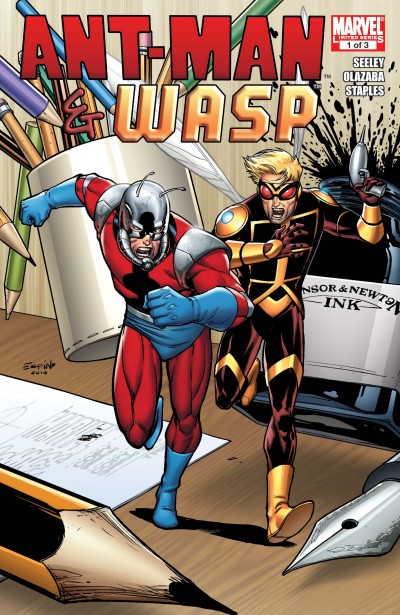 Secret Invasion event, the character to die was Janet van Dyne, the original Wasp. Following this, Hank Pym adopted his fifth costumed identity to honor her – becoming the second Wasp.
Secret Invasion event, the character to die was Janet van Dyne, the original Wasp. Following this, Hank Pym adopted his fifth costumed identity to honor her – becoming the second Wasp.
To Marvel editorial, having a new Wasp and a new Ant-Man must have seemed to have been begging for a storyline. In this miniseries, writer Tim Seeley delved more into the core of the original version of the Eric O’Grady character that Robert Kirkman had created. O’Grady was more lecherous and morally ambiguous than he had been in years. Seeley also brought back the Black Fox, the geriatric cat burglar who had been a minor supporting character during the Irredeemable Ant-Man series and his former girlfriend from that series, Abigail. The series also dealt with Hank Pym’s past – his former relationship with his ex-wife, his multiple identities, his friendship with the recently slain Bill Foster (the second Giant-Man, killed during the Civil War) and his own ongoing quest for redemption.
| Writers | Artists |
|---|---|
|
|
